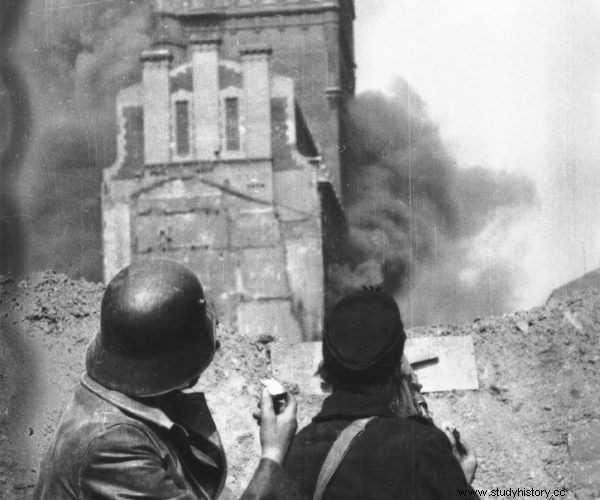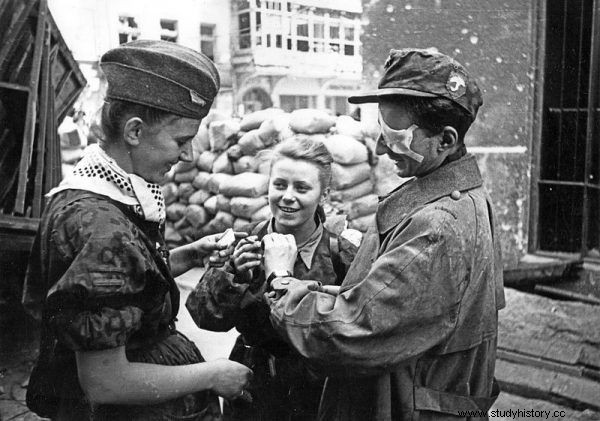They fought, loved and died. Women constituted up to 30 percent of the participants of the Warsaw Uprising. Nurses, liaison officers, cooks, puffs, but also snipers and minerals - it is largely thanks to their courage that the insurgents survived for so long. Who deserves a special place in the insurgent pantheon?
"Donut"
Wanda Traczyk, pseudonym "Pączek" in August 1944, was only 17 years old, and behind her - activity in the Little Sabotage, Gray Ranks and action N. She provided Nazi informers with letters warning against the death sentence. What pushed her to fight? As she recalls:
A bomb hit a neighboring house on the opposite side of the street (...) I saw a woman running out of the rubble of the building with a baby in a pillow in such a blanket. I saw the Germans shooting this woman, pointing the baby at it. I saw this child fall apart. (...) there was nothing but pulp . It was September, some sixteenth or seventeenth September. Later my attitude towards the Germans was clear .
During the Uprising - with a weapon in her hand! - she was sent to the disposable unit of Antoni Chruściel "Monter". At the turn of August and September '44, they made their way from the northern Śródmieście to the Old Town. The fight was very fierce. The Germans did not even allow wounded nurses to be taken from the street.
“The red cross was of no interest to them. These girls were dying for three days because it was impossible to come - said Wanda years later. "The most wonderful, the bravest were nurses (...) went unarmed and still had to carry them, they couldn't run, they had to pick up the wounded, put them on a stretcher."
In September 1944, the girl fought, among others, in Nowy Świat. In her memories, the face of a fatally wounded boy, whom she risked his life, escaped from under the bullets remained:
(...) he was hit in the stomach, his intestines spilled out onto the road, the barricade was already partially broken. (...) At some point I managed to put these intestines on the boy's stomach and tie his legs (...). And I pulled him off in such a way that they dragged me. (…) And when he was on Chmielna Street, I held him in my arms. He had tears running down his face, but he was already dying. It was an amazingly beautiful boy with such blue eyes, such long lashes.

When the Warsaw Uprising broke out, Wanda Traczyk was 17 years old.
After the fall of the uprising, "Pączek" was taken to the stalag. In 1947 she returned to Poland. She graduated in psychology from the University of Warsaw. In later years, she was involved, among other things, in the search for insurgent graves. She has been an honorary citizen of Warsaw since 2017.
“Baśka - Bomba”
August 20, 1944. 2 o'clock at night. The side of the building at 39 Zielna Street is lit by a flash of explosions. You hear gunshots, and a flamethrower from a fire engine pump sends flames deep. The action of recovering PASTA (Polska Akcyjna Spółka Telefoniczna) is underway. The Germans are fiercely defending themselves in the characteristic Warsaw skyscraper. Snipers take a bloody toll from above.
The first chord of the operation was the breach through which the insurgents entered. This task was given to only 21-year-old minerka, Barbara Matys with the pseudonym "Baśka - Bomba" , and her two friends:"Iza" - Wanda Maciejowska and "Hanka" - Irena Grabowska. Around midnight, a mining patrol under the command of Captain Jerzy Skupieński "Jotes" got to the annexe of a neighboring tenement house. They placed the cargo on the third floor. The detonation was performed by "Jotes" personally. "Baśka" later recalled:
The outburst was terrible, we had a bad head at all, and as soon as the dust settled, we immediately [moved] forward. (...) The Germans had their machine guns already running and they were already shooting. There were the first wounded who fell off the ladder and our "Iza" was injured in the heel. "Hania" withdrew with her, and I continued to follow "Jotes". We ran into some room that already had hell.
The mining equipment of Baśka-Bombs came in handy again when the group found themselves trapped. As she said:
Our machine gun has jammed and we are lost in all of this. We have to get out, because we are going to fry, we will suffocate. Then my loads, which I had in my haversack, started to move. It was not known how thick the wall was, how it would be successful, because there were only three-centimeter pieces of fuse with primers. Three centimeters is three minutes to retire after firing.
After the explosion, to save themselves, they jumped from the third floor to the rubble. Some could not cope and were pushed out by the commander. Barbara Matys jumped alone.
After the fall of the uprising, "Baśka - Bomba" was sent to a transit camp in Ożarów, and then to stalag 344 in Lamsdorf, where she worked in the camp hospital. Apparently, due to the complete lack of fear towards the occupant, she earned respect from the Germans . After the war, she had to endure harassment from the communist security services. A negative opinion from the Security Service had ruined her chances of studying medicine. So the heroine of the Warsaw Uprising worked as a children's nurse until her retirement.
"Angel"
Jadwiga Klarner-Szymanowska, pseudonym "Aniołek" on August 1, 1944, told her mother that she was leaving for a few days. She took the first aid kit with her and went to the collection. She was then 22 years old. It quickly turned out that he would not come home on time. After the first fights, heard that she was to organize ... an insurgent hospital on her own.
She became an "angel" thanks to Henryk Różniewski, "Zakapior". The charming nurse seemed almost heavenly to the partisan as she dressed his wounded face. This is also how the romance of a girl from high society (her father, Czesław Klarner, was the Minister of the Treasury in the Second Polish Republic) began with an ordinary boy.
“In the insurgent Warsaw, such situations were commonplace. Therefore, this time no one was offended by the fact that the daughter of the former minister of the treasury was adored by a soldier who ate bread from more than one oven "- he writes in the book" Miłość ". 44 true stories of insurgent love ”Agnieszka Cubała.

The female soldiers from the uprising participated, among other things, in the action of acquiring PAST. The photo shows the insurgents from the "Kiliński" battalion, the burning building of the building.
The hospital in Mokotów survived almost until the end of September 1944. At that time, the Germans strangled the uprising bloodily with heavy artillery, the so-called "cows". Jadwiga later recalled:
There were graves in the makeshift cemetery. I remember a young boy brought by my colleagues from the ward. He was unconscious. At first glance, there was no wound or injury to be seen. Colleagues laughed that the simulator that he was fine, just "hit the whistle" - because the boy was whistling, constantly whistling.
Only after carefully examining the head, I found a small, round, almost bleeding wound hidden under the hair above the temple - the ball mouth. Maybe if this was a "real" x-ray hospital, with a neurosurgeon, maybe the boy could be saved. He whistled all night, one note, incessantly. In the morning he died .
On September 26, the hospital ceased to exist and "Aniołek" was taken prisoner by the Germans. However, she managed to escape, thanks to ... German guards. “A patrol enters the barracks. Typical Švejkas:older, fat, good-natured, in slightly disheveled uniforms. They start chatting with us. They say:- We are not Germans, we are Bavarians, Catholics, and you - she said.
The Germans let themselves be bribed with a decorated bracelet and led Jadwiga to a hole in the fence . After the war, the girl found her brother and parents who also managed to survive. In communist Poland, she did not admit to the insurgent past. She graduated from medicine. She became a doctor specializing in childhood diseases.
"Slawek"
“The sudden crying that has accumulated for so many weeks shakes me up. I cry for all the times. (…) I feel like I'm close to fainting. The caretaker takes me to her place, washes me completely, scrubs me, feeds me. He cuts out a part of my matted and tangled hair, which cannot be combed out, ”wrote Wiesława Kamper, a seventeen-year-old liaison officer in her notebook. The girl, nicknamed "Sławka", was a soldier in the Parasol battalion. And she just came out of the sewers.
She miraculously avoided death there. Her legs refused to obey with exhaustion and she sank into the water. Another soldier saved her - from the "Zośka" battalion. However, it was not the end of the dramatic experiences. The girl fell into despair when it turned out that her family home was empty and her beloved from the ward was dead.
I am talking about "Fabian", or 21-year-old Janusz Werner, who often appeared in the diary of "Sławka". The boy withdrew from the manhole in Czerniaków together with his friend who had heart disease. They both died from a series of Nazi rifles - or so Wiesława thought. In the book "Love '44" Agnieszka Cubała explains:
After many years, "Sławka" received a message that "Fabian" survived. He then hid in the basement. Under the cover of night, he crawled to the bank of the Vistula and swam to the right side. They both met one day on one of the streets of Warsaw. But then each of them had their lives arranged ...
"Zojda"
The liaison officer of "Parasola" with the pseudonym "Zojda", that is Zofia Świerszcz (her husband - Łazor), also made its way from Mokotów to Śródmieście. In her case, the nightmare of wandering in a tangle of sewers lasted as long as 18 hours . Years later, she said:
I had a high fever and only dreamed of sitting down, but when I sat down my head was plunging into the channel. This channel was nightmarish and macabre. When we got to Śródmieście through the sewer (...), they put us on the pavement and at some point I looked up and saw beautiful, autumn leaves on the tree.

"Zojda" served in the "Parasol" battalion. The photo shows other soldiers from her group.
"Zojda" was only 16 when the uprising broke out. Before the W hour came, she had already participated in combat operations as part of the so-called "Heads", that is, in the liquidation of SS-men who handed over civilians to death. Apart from that, she dealt with the reconnaissance, as well as smuggling press and weapons.
“ There were several times before the uprising that I felt I should not be part of the killing. But the circumstances were such that I had to "- she once confessed. After the uprising, it joined the Polish forces in the West. In the times of the Polish People's Republic, she was involved in, among other things, running veterans' organizations. She died recently - in January 2019. She was buried in Powązki. There are always lit candles on her grave.
